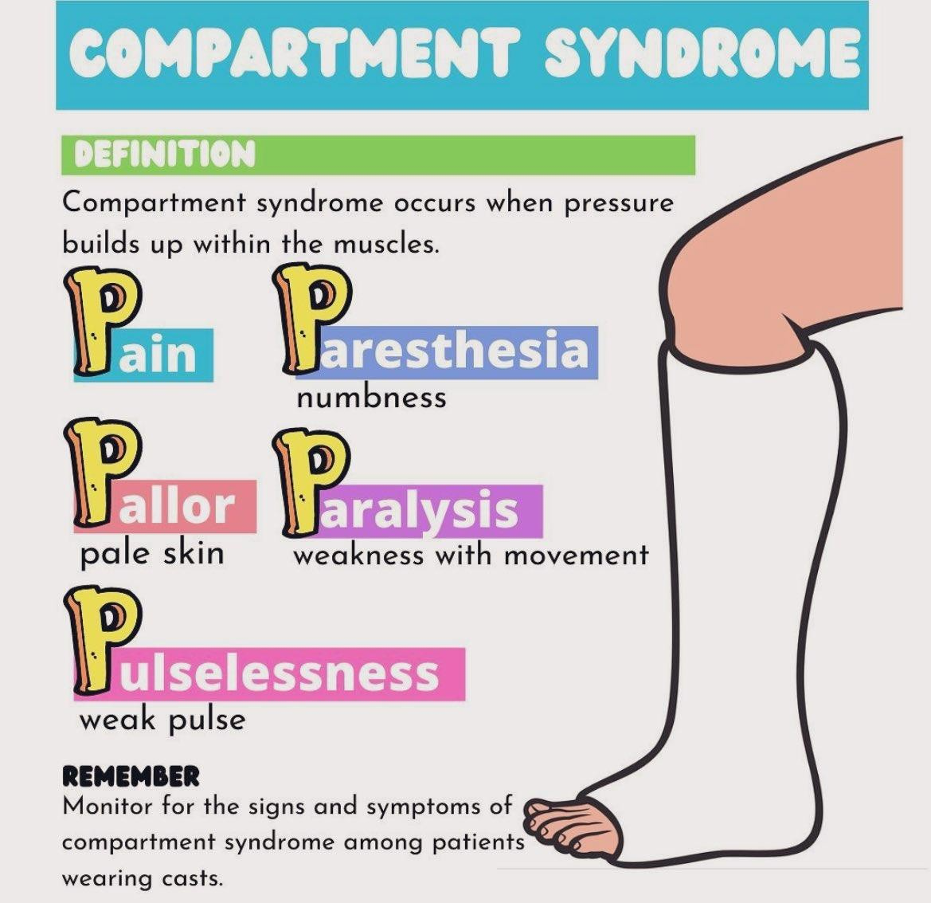A boy who has fractured his forearm is unable to extend his fingers. The nurse knows that this
may indicate damage to the epiphyseal plate.
is normal following this type of injury.
may indicate compartment syndrome.
may indicate fat embolism.
The Correct Answer is C
Compartment syndrome is a condition that can occur following an injury, such as a fracture, where there is increased pressure within a closed space (compartment) in the body. In the case of a forearm fracture, swelling and increased pressure within the compartment can lead to compression of the nerves and blood vessels, resulting in symptoms such as pain, numbness, and decreased function of the affected muscles.
The inability to extend the fingers suggests impairment of the extensor muscles, which are innervated by the radial nerve. If the radial nerve is compressed or injured due to compartment syndrome, it can result in a loss of function in the muscles it innervates, leading to the inability to extend the fingers.
damage to the epiphyseal plate in (option A) is incorrect because it, is not related to the inability to extend the fingers. The epiphyseal plate is the growth plate in long bones, and damage to it would typically affect bone growth rather than finger extension.
, stating that it is normal following this type of injury in (option B), is incorrect. Inability to extend the fingers is not a normal or expected finding after a forearm fracture. It suggests a potential complication or underlying issue.
fat embolism in (option D) is incorrect because it, is unlikely to cause an inability to extend the fingers. Fat embolism occurs when fat globules from a broken bone enter the bloodstream and can lead to respiratory and neurological symptoms, but it would not specifically cause an isolated loss of finger extension.

Nursing Test Bank
Naxlex Comprehensive Predictor Exams
Related Questions
Correct Answer is A
Explanation
The nurse's best response to the student nurse regarding why peer relationships become more important during adolescence is option A. Peer relationships become significant during adolescence because they provide adolescents with a sense of belonging. During this developmental stage, adolescents are transitioning from a primary focus on their family to a greater emphasis on peer interactions and social connections. Peer relationships offer a sense of acceptance, support, and identity as adolescents strive to establish their own identities separate from their families.
adolescents dislike their parents in (option B), is not a correct or comprehensive explanation for the increased importance of peer relationships during adolescence. While it is common for parent-child conflicts to arise during this stage, it does not imply that adolescents dislike their parents as a general rule.
suggesting that adolescents no longer need parental control in (option C), is not correct. While adolescents are seeking increased independence and autonomy, they still require parental guidance and support. Parental control and involvement continue to be essential in providing a secure and nurturing environment during adolescence.
They promote a sense of individuality in adolescents in (option D), is incorrect. Peer relationships do contribute to the development of individuality by allowing adolescents to explore their own interests, values, and social roles. However, the primary reason for the increased importance of peer relationships during adolescence is the sense of belonging and social acceptance they provide.
Correct Answer is A
Explanation
Graves' disease is an autoimmune disorder that affects the thyroid gland and results in the overproduction of thyroid hormones. Treatment for Graves' disease typically involves medications to regulate thyroid function. Adherence to the medication regimen is crucial for managing the disease and controlling symptoms.
By prioritizing the goal of verbalizing the importance of adherence to the medication regimen, the nurse aims to educate the adolescent about the significance of taking medications as prescribed. This education can help the adolescent understand the impact of medication non-adherence on their health and encourage them to actively participate in their treatment.
, developing alternative educational goals in (option B) is incorrect because it, is not directly related to the management of Graves' disease and its treatment.
allowing the adolescent to make decisions about whether or not to take medication in (option C) is incorrect because it, is not appropriate for a condition like Graves' disease where medication adherence is necessary for disease management. In this case, the nurse should focus on providing education and support to help the adolescent understand the importance of medication compliance.
relieving constipation in (option D) is incorrect because it, may be a consideration if constipation is a symptom experienced by the adolescent with Graves' disease. However, it is not the priority nursing goal as compared to ensuring adherence to the medication regimen, which directly addresses the management of Graves' disease.
Whether you are a student looking to ace your exams or a practicing nurse seeking to enhance your expertise , our nursing education contents will empower you with the confidence and competence to make a difference in the lives of patients and become a respected leader in the healthcare field.
Visit Naxlex, invest in your future and unlock endless possibilities with our unparalleled nursing education contents today
Report Wrong Answer on the Current Question
Do you disagree with the answer? If yes, what is your expected answer? Explain.
Kindly be descriptive with the issue you are facing.
